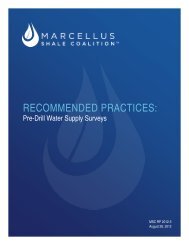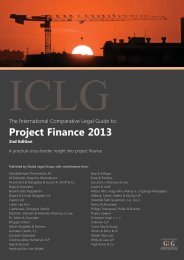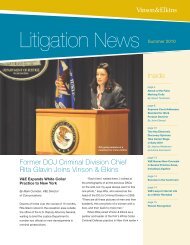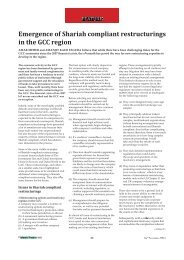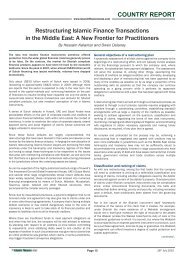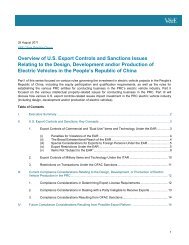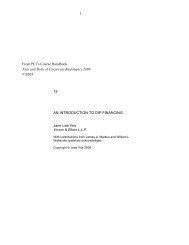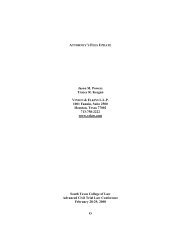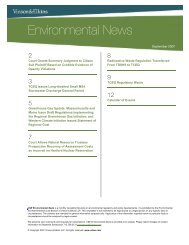TEXAS TRANSNATIONAL LAW QUARTERLY - Vinson & Elkins LLP
TEXAS TRANSNATIONAL LAW QUARTERLY - Vinson & Elkins LLP
TEXAS TRANSNATIONAL LAW QUARTERLY - Vinson & Elkins LLP
You also want an ePaper? Increase the reach of your titles
YUMPU automatically turns print PDFs into web optimized ePapers that Google loves.
<strong>TEXAS</strong> <strong>TRANSNATIONAL</strong> <strong>LAW</strong> <strong>QUARTERLY</strong> – June 2009Criminal penalties may also be sought by theEPA for knowing violations of the CAA or theEPA’s rules. Significantly, however, the billpassed by the House drops provisions in earlierversions that created liberal standing provisionsfor citizens to bring suit to enforce ACESA.Title IV – Transitioning to a Clean EnergyEconomyPreserving Domestic CompetitivenessSubtitle A begins by establishing an annualrebate program for certain industrial sectorsbased around the concept of “carbon leakage.”This term is defined as any substantial increasein GHG by manufacturing entities located incountries without commensurate GHG regulationsthat is “caused by an incremental cost ofproduction increase in the United States” due toU.S. GHG regulations.Certain energy-intensive, greenhouse-gasintensive,and trade-intensive sectors andsubsectors (defined through the six-digitclassification in the North American IndustrialClassification System (NAICS)) will bepresumptively eligible for the rebate program. Inaddition, any person may petition the EPA todesignate a sector as rebate-eligible. Theamount of rebate available is calculated by anentity according to a defined formula taking intoaccount the entity’s cost of compliance withGHG regulations, manufacturing output, GHGemissions-intensity, and electricity efficiency.Eligible industrial sectors would be determinedno later than June 30, 2011, along with the initialvalue of rebates per unit of production for eachsector.By February 1, 2013, the EPA must publish thefirst updated list of eligible sectors and rebatevalues, with future updates required every fouryears. Rebates in the form of emissionallowances will be distributed for each vintageyear no later than October 31 of the precedingcalendar year. Beginning in 2026, the rebateamount is to be reduced by 10 percent annuallyuntil the rebate program is phased out.Additionally, the rebates applicable to aparticular sector may be subject to anaccelerated ten year phase out period based ona Presidential determination that more than85 percent of the global output from a sector ismanufactured in countries that are parties to aninternational climate change agreement, orotherwise have a GHG intensity comparativelyless than that of the comparable U.S. sector.International Reserve AllowancesSubtitle A also states that, absent U.S.participation in a multilateral climate changeagreement meeting certain specified objectivesby January 1, 2018, or a finding that aninternational reserve allowance program wouldnot be in the national economic interest as to aparticular sector, the President shall establish aninternational reserve allowance program foreach eligible industrial sector. Should thePresident make such a finding that aninternational reserve allowance program isunnecessary as to a particular sector for thereasons set forth above, a joint resolution ofCongress is necessary to approve such adetermination to avoid imposing the program.If an international reserve allowance program isestablished, the EPA, in conjunction with U.S.Customs and Border Protection, must adoptrules requiring U.S. importers in identifiedsectors to purchase international reserveallowances. The program could take effect asearly as January 1, 2020. The EPA would alsoset the price of the allowances equal to theauction clearing price established at the mostrecent emission allowance auction, and set fortha methodology for determining the quantity ofinternational reserve allowances to be tenderedin conjunction with the importation of a coveredgood. However, covered goods produced ineither “foreign countries that the United Nationshas identified as among the least developed ofdeveloping countries” or foreign countriesresponsible for less than 0.5 percent of the totalglobal GHG emissions would be exempt fromthe program.Exporting Clean TechnologyUnder Subtitle D, the President is to establish an“interagency group” which will determine theeligibility of developing countries to receiveassistance to encourage widespread deploymentof technologies that reduce GHGemissions and to encourage the adoption ofpolicies that substantially reduce emissions ofGHGs. In addition, the assistance willencourage compliance with existing international- 18 -




